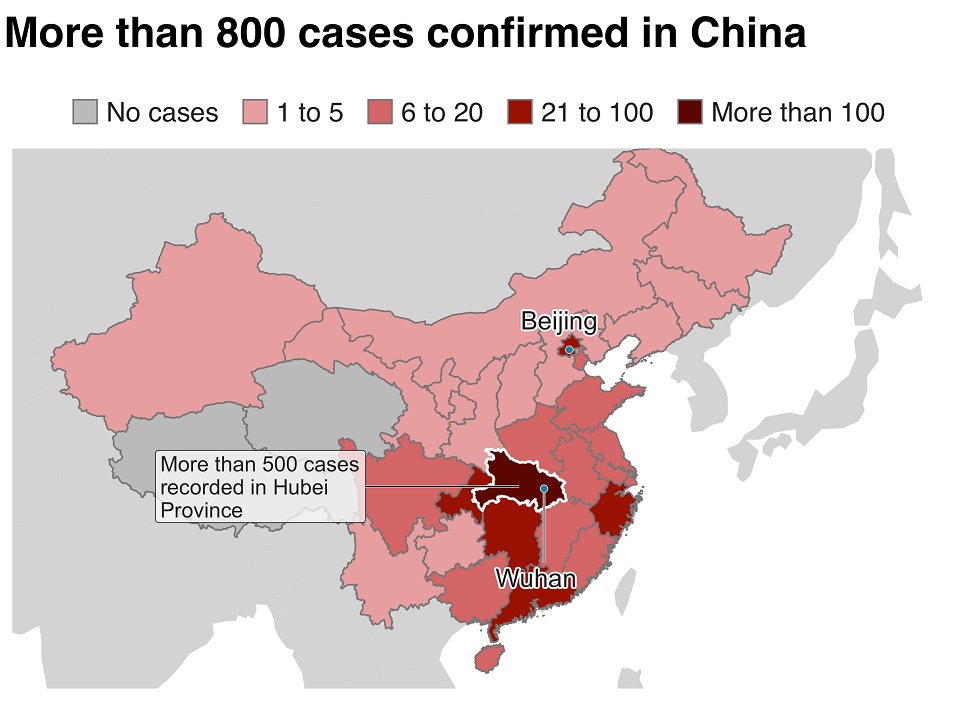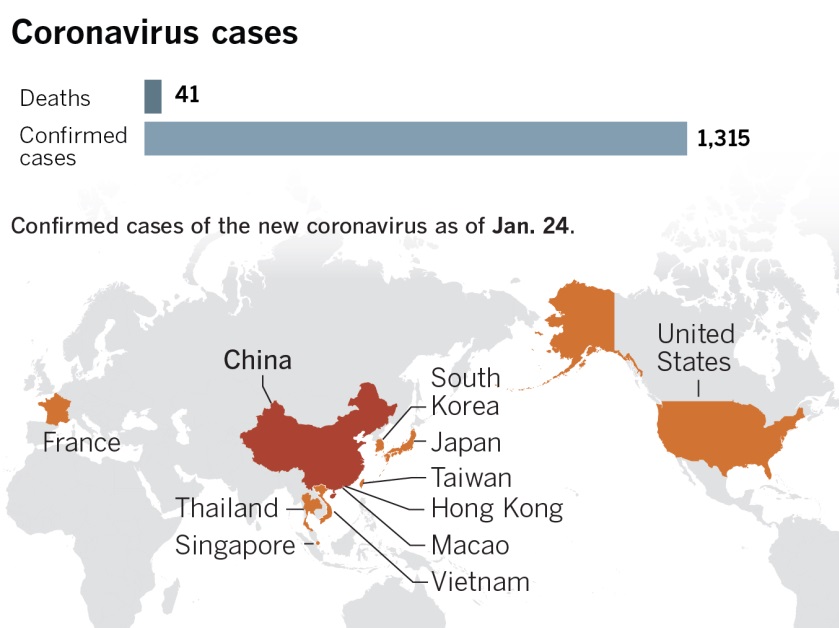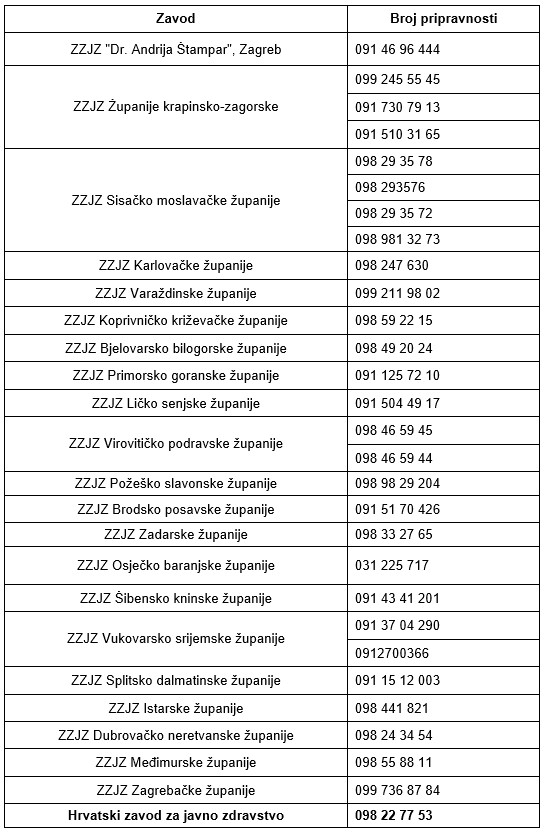Chinese Tourists From Coronavirus Epicenter Wuhan City Arrive in Croatia
A bus of Chinese tourists from Wuhan, the Chinese city where the Coronavirus epidemic was first detected, recently arrived in Croatia. Just before noon yesterday, the bus reached the border crossing at Bregana.
*Follow this page for updates from Total Croatia News on the coronavirus in Croatia. Contact numbers for epidemiologists, travel advisories and measures for preventing the spread of the coronavirus can be found here.
According to reports, they arrived in Europe by plane to Milan, and arrived by bus to Croatia. Before their arrival in Croatia they were screened for signs of the virus at Milan airport. No one showed symptoms of the disease, as reported by Index on January 25,2020.
Chinese Tourist Bus Driver Advised by Croatian Epidemiologists
They stopped at Bregana and were instructed what to do if they notice symptoms. As Index learned, the bus driver also received the phone number of epidemiologists and must contact them if any passengers show any symptoms of the Coronavirus.

Croatian Institute of Public Health Issues Travel Advice for China
The Croatian Institute of Public Health was informed of the event and had previously issued precautions for travelers going to China and returnees or tourists from China, as reported by Iva Tatić/Total Croatia News on January 25, 2020. Those precautions follow below:
In view of the emergence of a new Coronavirus in China and the unknown about transmission routes, HZJZ advises international travelers traveling to affected areas to follow the usual precautions advised to reduce the risk of other travel-related diseases (i.e. alimentary infections which are transmitted by fecal-oral means or insufficiently processed foods, respiratory infections transmitted by aerosols and droplets, sexually transmitted diseases transmitted by unprotected sexual contact, blood-transmitted diseases transmitted by the sharing of drug and drug injection supplies).
- Avoiding close contact with people who have an acute respiratory infection.
- Frequent hand washing, especially after direct contact with people who are ill or while in their surroundings. If contact with an affected person cannot be avoided, use a surgical mask to cover your mouth and nose, do not touch your eyes, mouth of nose after contact with the patient. And mandatory washing and disinfection of hands after contact with the patient.
- Avoiding close contact with live or dead animals: both domestic and wild animals.
- Consuming properly processed foods, preferably immediately after preparation; thorough peeling of fruits and vegetables, drinking bottled water without ice.
- Avoidance of unprotected sexual intercourse with persons whose health status is unknown.
- Avoiding the sharing of drug paraphernalia (or illicit drugs) with others.
Health Precautions for Travel Returnees
Measures to reduce the spread of the disease on and upon return from the affected area:
- Passengers who have symptoms of acute respiratory infection should cover their nose and mouth with disposable wipes and wash their hands when coughing and sneezing.
- If an international traveler becomes ill, he/she is advised not to travel during the illness for several reasons: The demands of the journey may worsen his/her health. In some countries a passenger will not be allowed to board a means of transport (airplane, ship, train, bus) if he/she is recognized to be ill due to the possibility of transmitting the infection to other passengers.
- If the passenger becomes ill while traveling in a vehicle in international traffic, they should report their symptoms of the disease to staff to ensure that the patient remains comfortable and has the necessary protective equipment (surgical mask), medication (antipyretic, analgesic), and so that arrangements can be made for the patient with be met at the destination by the local health service.
- If a passenger develops fever and/or coughing and breathing difficulties within 14 days of leaving the affected area (at this time, Wuhan City is considered the only affected area), the doctor should be informed and informed that he/she has stayed in Wuhan for (or other affected area, if identified).
"The reason for promptly reporting a passenger with a fever with respiratory symptoms to a physician is to permit timely diagnosis and determine the true cause of the disease. It is much more likely that the returning traveler has the flu or other respiratory illness than the disease caused by the new Coronavirus. It also enables timely initiation of the proper treatment, prevention of further transmission of the disease to persons in close contact and ensures the necessary monitoring of the health persons who have been in close contact with the patient.
A returnee from the affected area may announce his/her arrival by telephone to the doctor to avoid staying in the waiting room and to arrange a way of arrival (it is not advisable for the patient to travel by public transport). If he/she does not know who to contact, the person may call the local epidemiologist or the epidemiologist of the Croatian Institute of Public Health for advice," the HZJZ advised.

What have scientists discovered about the Coronavirus so far?
The new Coronavirus has taken scientists by surprise according to Index on January 26, 2020. They do not know exactly where it originated, but it has already traveled 9500 kilometers since being discovered in China at the end of December. Despite quarantines, the epidemic is spreading. The number of fatalities is on the rise too.
If this was a Hollywood movie, now would be the time to panic. However, most people just need to wash their hands and continue going about their daily lives.
"Don't panic if you're not paid to panic," says epidemiologist Brandon Brown of the University of California, who has studied many deadly epidemics. "Health professionals need to be on standby and governments need to provide them with resources. Timely and accurate publicity is the key, and everyone else can relax," Brown adds.
Within three weeks of the outbreak, which spread to at least 941 people in 11 countries, scientists learned more about the virus. It is a Coronavirus, a relative of the pathogen causing Severe Acute Respiratory Syndrome (SARS) and Middle Eastern Respiratory Syndrome (MERS), a disease that has caused hundreds of deaths worldwide.
Other Coronaviruses cause nothing more severe than a cold. In addition to humans, Coronaviruses can infect cows, pigs, cats, chickens, camels, bats and other animals. Most of the initial victims of the current epidemic reported they had visited a large '' live market '' in the Chinese city of Wuhan, suggesting that the virus had passed from a different species to humans.
Coronavirus Causes Only Mild Symptoms in Young and Healthy
When experts examined the genetic code, they found a sequence previously unknown to science. This means that humans have not been able to develop natural immunity to the Coronavirus called n-CoV2019. Fortunately, it seems to only cause mild symptoms in young and healthy people. Most of the reported deaths are occurring in people over 50, those who have been previously ill or have weakened immune systems. "So far, we have no evidence that this is more dangerous than the flu. Most people will be fine with decent medical care," reports Michael Mina, an epidemiologist at Harvard.
"In fact, it is possible that hundreds or thousands of people have already been infected in China and elsewhere but have experienced such mild symptoms that no one has noticed," adds Tom Inglesby, director of the Johns Hopkins School of Public Health. "It's too early to know. In new outbreaks; the most severe cases are often identified first and can result in a distorted picture of how dangerous the situation is," Inglesby points out.
Information Updates Spreading Faster Than Coronavirus
Epidemiologists are now trying to find out when the new Coronavirus acquired the ability to transmit from person to person since the public market in Wuhan, which is considered the starting point, is clearly no longer the source of the epidemic's spread. Health workers expect human-to-human spread to continue in the short term, which means new cases will emerge across Asia, in the US and possibly in Europe. The news is that information about the virus is spreading faster than a virus.
The SARS epidemic erupted in 2002 in the Chinese province of Guangdong and by the time of its suppression in 2003; it had killed 774 people in 29 countries. The registered number of patients exceeded eight thousand. However, at the beginning of the crisis, the Chinese government was falsifying the number of sick people, refusing assistance from abroad, which undermined the ability of their own citizens to protect themselves. The public outrage led to the resignation of the Chinese Health Minister.
This time it's different. Chinese authorities quickly informed other countries of the epidemic's development. They also shared the genetic sequence of the virus, which can help epidemiologists track its spread and predict what to do next.
"This is definitely not 2003. The speed at which the virus was identified is a testament to that," adds Michael Mina from Harvard.
Scientists Develop Diagnostic Test Within 24 Hours
After receiving the Coronavirus genome, it took scientists 24 hours to develop a diagnostic test.This fact further supports the argument to avoid panic. The rapid increase in the number of patients can be misleading. Before the diagnostic test was developed, doctors had no reliable way of distinguishing n-CoV2019 virus infection from the virus causing pneumonia. And that means the number of registered cases will now skyrocket.
"You may hear about 300 new cases, but maybe 300 were before. An increase in the number of patients may not mean spreading the virus, but better detection," she added.
Follow our Lifestyle page for updates on the spread of Coronavirus and recommended protective measures for Croatia and abroad.
*Follow this page for updates from Total Croatia News on the coronavirus in Croatia. Contact numbers for epidemiologists, travel advisories and measures for preventing the spread of the coronavirus can be found here.
What is Croatia Doing to Prevent the Spreading of the New Coronavirus?
January the 25th, 2020 - As soon as news of the potential epidemic spread of the new coronavirus broke in the international media, the Croatian public also started worrying about the deadly virus and started asking what has been done to prevent the spreading of the disease into Croatia.
DAILY UPDATES: Total Croatia News provides LIVE daily updates on the coronavirus epidemic here.
There is no clear answer to that question.
As soon as the situation on the international scale became clear, warnings that there's an increased probability of the virus coming into Croatia because of the number of Chinese workers working on Pelješac bridge surfaced, and that lead to Croatian journalists and columnists examining the imminent danger to the Croats and the state's health system. While it's not entirely clear how worried we should be about the emerging threat (with numerous scientists and publications saying that the mortality rate for the patients suffering from the coronavirus-caused pneumonia is significantly lower worldwide than the mortality rate related to seasonal flu, which nobody is really worried about), some of the institutions in Croatia have reacted to the potential threat.
The Croatian Ministry of Health has published their very brief set of recommendations (opens a .doc file in Croatian) for the travellers to and from China, and the Croatian Institute of Public Health has published their overview of the situation.
The Ministry warns those travelling to China to avoid sick persons, to avoid animals (both living and dead) as well as markets, not to eat any raw or semi-cooked animals, to wash their hands often (!) and to notify their doctor of their plans to travel to China.
For the travellers returning from the regions of China where coronavirus has been confirmed, and if you have a fever, cough or have trouble breathing, they want you to seek medical attention (but call before coming to your medical professional to inform them you've been to China), not to travel while sick, to avoid contact with other people, to cover your mouth with a handkerchief while coughing or sneezing and to wash your hands often (!).
The Croatian Institute of Public Health (HZJZ) has published a more comprehensive review of the situation, explaining more about the disease and its spread in the population. Their recommendations for the travellers to and from China (especially the Wuhan region) are similar, although they do provide the list of the epidemiologists on call to assist with any questions and worries.

At the same time, the Croatian Ministry of Foreign and European Affairs allegedly informed the public, and subsequently it was reported by the Croatian media, that four Croatian citizens are believed to be in the Wuhan region: three of them working there, and one visiting. All of them are reported to be healthy, but the Ministry doesn't recommend travel to certain Chinese regions (it hasn't been fully specified which) because of the dangers of the infection.
So far, the active measures of protection against the virus at the Croatian airports have not been introduced.
That means that people arriving to Croatia will not have their temperatures taken in order to determine which of them have a high temperature. The airports in Croatia are prepared, though, going through the passive measures and being vigilant, especially as we know that there are a number of managers working on Pelješac bridge expected to return to Croatia after having celebrated the Lunar New Year in China.
DAILY UPDATES: Total Croatia News provides LIVE daily updates on the coronavirus epidemic here.

